Ice cream lovers won’t be surprised that the UK market is growing 5 per cent year on year. According to market research company Statista, almost 30 per cent of UK ice cream consumers would be open to trying vegan and/or reduced-sugar ice creams. But is ice cream really that bad for us, and are the “healthier” versions that are appearing any better?
Traditional ice cream is just a combination of cream, milk, sugar and eggs but there are some potential health downsides, as Nichola Ludlam-Raine, dietitian and author of frothcoming book How Not to Eat Ultra-Processed, explains: “Ice cream is often high in sugar and fat, which, if eaten in excess, can contribute to weight gain and an increased risk of chronic conditions like Type 2 diabetes and heart disease.”
“Many commercial ice creams also contain ultra-processed food (UPF) additives such as stabilisers, emulsifiers, and artificial flavours, making them moreish and even easier to eat, leading to overconsumption and potentially displacing more nutritious whole foods.”
Happily, ice cream does have some nutritional value. Its carbohydrate and calorie content provides a quick source of energy and it offers some essential nutrients like calcium and iodine from dairy, which are important for bone health and thyroid function. And what about vegan and low-sugar ice creams? Are they any better for us?
Ludlham-Raine advises caution: “Ice creams marketed as healthier options can sometimes be higher in sugar than regular ice cream and contain various UPF additives to mimic the texture and taste of regular ice cream.”
So grab a spoon, it’s time to put the nation’s favourites, and some of the “healthy” newcomers, to the test.
All nutritional information given is per 100g, which is equivalent to a medium-sized scoop.
Carte D’or Madagascan Vanilla Ice Cream
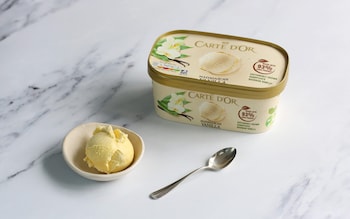
Nutrition per 100g: 186kcal, saturated fat 6.7g, sugar 19g, protein 2.1g, salt 0.08g
Taste
This ice cream packs a pleasing vanilla punch and isn’t overly sweet. The texture was a little too light and airy for my liking, but overall it’s a good, basic vanilla ice cream.
Health
This ice cream sits in the middle of the pack for fat and sugar content. Nonetheless, it’s high in saturated fat according to NHS recommendations, containing more than 5g/100g, and has nearly five teaspoons of sugar. The ingredients include a number of UPF stabilisers and emulsifiers, so unfortunately, it’s a low scorer for health.
Häagen-Dazs Salted Caramel Ice Cream
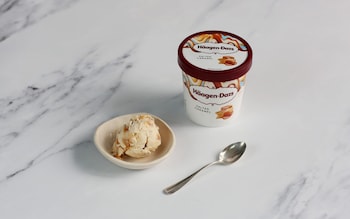
Nutrition per 100g: 275kcal, saturated fat 10.9g, sugar 25.3g, protein 4.0g, salt 0.5g
Taste
OK, it’s delicious; dense, creamy with plenty of tangy, salty caramel dotted throughout. A little too sweet for my palate but others will love it.
Health
Zero stars
There are going to be a few disappointed Häagen-Dazs fans out there – this ice cream contains the most calories, sat fat, sugar and salt of all those tested, in fact with 25.3g sugar it’s well over the 22.5g/100g that constitutes a high-sugar product, and having 0.5g of salt puts it in the “medium” category (low salt is anything under 0.3g/100g). It also contains UPF emulsifiers.
Ben & Jerrys Cookie Dough Vanilla Ice Cream
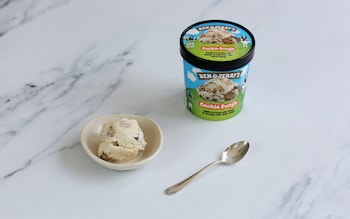
Nutrition per 100g: 273kcal, saturated fat 9.2g, sugar 25g, protein 4.1g, salt 0.17g
Taste
I found the cookie dough blobs rather gritty, which put my teeth on edge, and the vanilla ice cream was lacking in flavour but incredibly sweet. Given it’s the nation’s favourite tub, I was expecting to like this more.
Health
Zero stars
It might be a best-seller, but how does it stack up nutritionally? It ranks second highest after Häagen-Dazs for calories, saturated fat, and sugar and contains stabilisers and emulsifiers, so again, it’s nul points.
Ben & Jerrys Lighten Up Chocolate Cookie Dough Vanilla Ice Cream
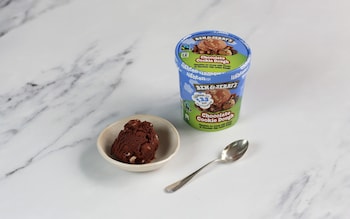
Nutrition per 100g: 208kcal, saturated fat 3.6g, sugar 24g, protein 4.7g, salt 0.15g
Taste
The cocoa flavour comes through well but considering the high sugar it’s strangely lacking in sweetness. The cookie dough was tasteless, dry, and brittle. I would opt for the regular Ben & Jerry’s and take the extra sat fat hit.
Health
The only thing that’s lighter here is the saturated fat, which is just over a third that of regular Ben & Jerry’s. The protein content is higher than most at 4.7g/100g, so we’ll give it a point for that. Otherwise, it’s still a high-sugar, UPF treat.
Swedish Glace Vanilla Non-Dairy Vegan Ice Cream
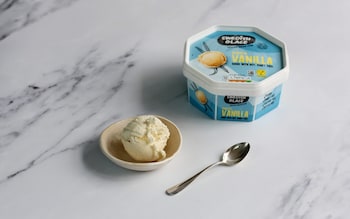
Nutrition per 100g: 174kcal, saturated fat 4.9g, sugar 22g, protein 1g, salt 0.21g
Taste
This put me in mind of Mr Whippy flavour-wise, not a bad thing. The texture was also more like a whipped dessert than ice cream, but it’s a tasty option if you are dairy-free.
Health
This is a little lighter in calories and saturated fat than some of the regular ice creams, but it’s still ultra-processed. It’s the lowest in protein (being dairy-free) and fourth highest in sugar at 22g/100g. Unless you are lactose intolerant, there’s no significant health benefit to choosing this.
Mackie’s Traditional Luxury Dairy Ice Cream
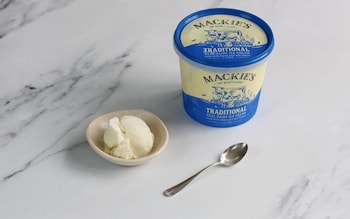
Nutrition per 100g: 192kcal, saturated fat 6.8g, sugar 18.2g, protein 4g, salt 0.17g
Taste
This had more of a fresh milk flavour than vanilla, and overall was a bit bland. The texture wasn’t as creamy as I was expecting. Rather disappointing.
Health
You’d be forgiven for thinking this “traditional” ice cream is healthier, but in truth there’s not much to separate it from the Carte D’or. They have very similar nutritional profiles, and although Mackie’s has slightly fewer ingredients, it still contains those ubiquitous UPF stabilisers and emulsifiers.
Halo Top Peanut Butter Cup
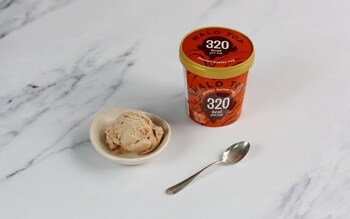
Nutrition per 100g: 131kcal, saturated fat 2.1g, sugar 13g, protein 4.8g, salt 0.47g
Taste
A lovely dense and creamy texture with a subtle peanut flavour, which was delicious. I would have loved some crunchy peanut pieces for a bit more bite.
Health
This has less than half the calories, saturated fat, and sugar than Häagen-Dazs and Ben & Jerry’s. It is also the highest in protein, with a respectable 4.8g per 100g. However, it does contain artificial sweeteners and other UPF additives, so it’s not exactly a health food.
Jude’s Flat White Coffee Ice Cream
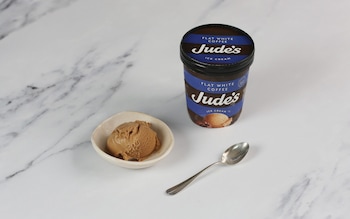
Nutrition per 100g: 116kcal, saturated fat 3.7g, sugar 12g, protein 2.9g, salt 0.1g
Taste
This ice cream is a Great Taste Award Winner and for good reason, it has a lovely smooth, creamy texture, a well-balanced, mellow coffee flavour and is not overly sweet.
Health
Definitely one of the healthier options, this ice cream has a modest calorie count and the lowest sugar content of all the tested products. Unfortunately, locust bean gum and guar gum, a couple of stabilisers listed in the ingredients, tip it into UPF territory. Nearly there.
Crosta & Mollica Gianduia Hazelnut & Chocolate Gelato
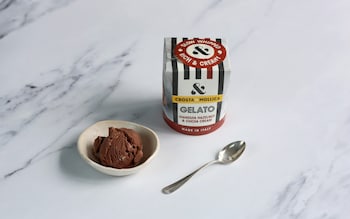
Nutrition per 100g: 139kcal, saturated fat 6.4g, sugar 17g, protein 2.6g, salt 0g
Taste
This had a very firm, dense texture and although not the lowest in sugar it almost needed more sweetness to counter the bitter hazelnut and cocoa flavours. One for those with less of a sweet tooth.
Health score
I was a little disappointed by this because Crosta & Mollica is my usual go-to non-UPF brand, but here they have included emulsifiers and stabilisers. This just reinforces the need to check the ingredients before you buy.
Yeo Valley Organic Strawberry Kefir Frozen Yogurt
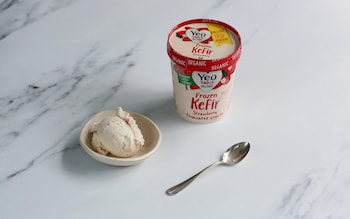
Nutrition per 100g: 76kcal, saturated fat 0.8g, sugar 13g, protein 3.1g, salt 0.11g
Taste
I enjoyed the light, slightly sorbet-like texture here, and the fresh strawberry flavour was delicious. It was not too sweet and had a pleasant yogurty tang from the kefir.
Health
This innovative product is very low in calories and saturated fat and one of the lowest in sugar. Kefir also contains lots of gut-friendly bacteria. Just a point knocked off for the use of UPF stabilisers.
Conclusion
Apart from some of the ice creams tested containing a reasonable amount of protein (Halo and Ben & Jerry’s Lighten Up) and being low-ish in salt, all were ultra-processed and many were high in sat fat and sugar (notably Häagen-Dazs and Ben & Jerry’s). So should we give up our beloved ice cream altogether?
Ludlam-Raine has this advice: “Look for good-quality, traditional ice cream that uses simple, natural ingredients without excessive additives. Remember, enjoying your favourite ice cream now and then is perfectly fine and can be part of a balanced diet.”
As for me, I’ll be picking up some more Jude’s and Yeo Valley Frozen Kefir next time I’m at the supermarket.
Photos by Clara Molden
Disclaimer: The copyright of this article belongs to the original author. Reposting this article is solely for the purpose of information dissemination and does not constitute any investment advice. If there is any infringement, please contact us immediately. We will make corrections or deletions as necessary. Thank you.



